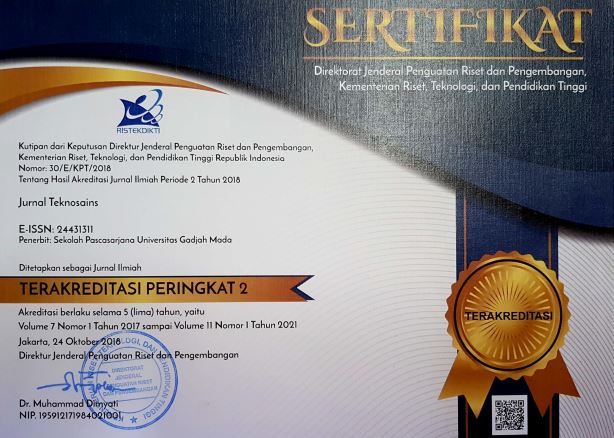SIMULASI ANTRIAN PASIEN RAWAT INAP UNTUK MENGURANGI WAITING LIST VIP DI RUMAH SAKIT
Frylie Frescia Falen(1*), Subagyo Subagyo(2)
(1) Departemen Teknik Mesin dan Industri, Gadjah Mada University
(2) Departemen Teknik Mesin dan Industri, Gadjah Mada University
(*) Corresponding Author
Abstract
Keywords
Full Text:
PDFReferences
Depkes. RI., 2005, Buku Petunjuk Pengisian, Pengolahan, Penyajian Data Rumah Sakit. Jakarta.
Fallen, F.F., 2008, Optimasi Pelayanan Penumpang Check InCounter di Bandara AdiSucipto Yogyakarta, Tugas Akhir, Program Studi Teknik Industri, Universitas Islam Indonesia, Yogyakarta.
Haghighinejad, A., Kharazmi, E., Hatam, N., Yousefi, S., Hesami, S.A., Danaei, M., Askarian, M., 2016, Using Queuing Theory and Simulation Modelling to Reduce Waiting Times in An Iranian Emergency Department. IJCBNM. 2016;4(1):11-26.
Harrel, C., Ghosh, B.K., Bowden, Jr., R.O., 2012, Simulation Using Promodel 3rd Ed, McGraw-Hill, New York.
Henry, Bustani, 2005, Fundamental Operation Research, PT Gramedia Pustaka Umum, Jakarta.
Janna, M., Wisniewski, M. L., Diana, V. A., Yeager, David, R. H, 2018, Comparison of objective measures and patients’ perceptions of quality of services in government health facilities in the Democratic Republic of Congo, International Journal for Quality in Health Care, Volume 30, Issue 6, 1 July 2018, Pages 472–479.
Kang, D., Byoung, K.C., 2011, The Extended Activity Cycle Diagram and Its Generality, Simulation Modelling Practice and Theory, 19, Pages 785– 800.
Keshav, N., 2015, Smart Queue Management for Hospitals, International Journal of Advance Foundation and Research in Computer (IJAFRC), Volume 2, Special Issue (NCRTIT 2015), January 2015. ISSN 2348 – 4853.
Law, A.M., Kelton, W.D., 1991, Simulation Modeling & Analysis Second edition, McGraw-Hill, New York.
Murthy, D.N.P, Page, N.W., Rodin, E.Y., 1990, Mathematical Modelling, A Tool for Problem Solving in Engineering, Physical, Biological and Social Sciences. Pergamon Press. Oxford.
Soegiharto, T.S., Asih, A.M.S., 2014, Simulasi Aliran Pasien Rawaat Inap untuk Mengurangi Bottleneck, Jurnal TEKNOSAINS, Vol. 4, No. 1, hal. 84 – 92.
Wasono, W.D.R., Sutjipto, T., Trijoko, W., 2005, Analisa Kelayakan Pembangunan Private Wing Di Rumah Sakit Pelabuhan Surabaya, Prosiding Seminar Nasional Manajemen Teknologi II Program Studi MMTITS, Surabaya 30 Juli 2005.
Article Metrics
Refbacks
- There are currently no refbacks.
Copyright (c) 2018 Frylie Frescia Falen

This work is licensed under a Creative Commons Attribution-ShareAlike 4.0 International License.
Copyright © 2024 Jurnal Teknosains Submit an Article Tracking Your Submission
Editorial Policies Publishing System Copyright Notice Site Map Journal History Visitor Statistics Abstracting & Indexing









